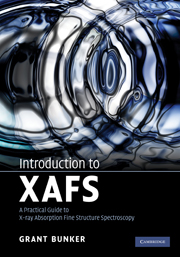Book contents
- Frontmatter
- Contents
- Preface
- 1 Introduction
- 2 Basic physics of X-ray absorption and scattering
- 3 Experimental
- 4 Theory
- 5 Data analysis
- 6 Related techniques and conclusion
- Appendix 1 Introduction to Fourier transforms in EXAFS
- Appendix 2 Cumulants in EXAFS
- Appendix 3 Optimizing X-ray filters
- Appendix 4 Reference spectra
- Appendix 5 X-ray tables
- References
- Index
5 - Data analysis
Published online by Cambridge University Press: 25 January 2011
- Frontmatter
- Contents
- Preface
- 1 Introduction
- 2 Basic physics of X-ray absorption and scattering
- 3 Experimental
- 4 Theory
- 5 Data analysis
- 6 Related techniques and conclusion
- Appendix 1 Introduction to Fourier transforms in EXAFS
- Appendix 2 Cumulants in EXAFS
- Appendix 3 Optimizing X-ray filters
- Appendix 4 Reference spectra
- Appendix 5 X-ray tables
- References
- Index
Summary
In the process of data analysis one creates a hypothetical model of the data containing unknown parameters or functions that are to be determined through comparison with experimental data. Once the model is established, the goal is to identify and then describe the regions within the space of parameters that are consistent with the data, within the experimental and theoretical uncertainties.
The “forward” problem – calculating spectra for a hypothetical set of structural parameters – has been the principal activity in XAFS theory in recent decades. The inverse problem – determining structural parameters from a set of data – usually is handled through fitting and some kind of statistical analysis to generate confidence limits on the determined parameters. Nevertheless a variety of methods have been developed for solving the inverse problem in a direct manner. Some of these methods are briefly described at the end of this chapter.
XAFS data depend on the types and dispositions of atoms and the variation of those structural parameters over the sample volume. Modeling the structural variation in a sufficiently accurate manner without introducing too many parameters is often the trickiest part of formulating a fitting model. Near-edge spectra furthermore can be sensitive to oxidation states, either directly by introducing vacancies in bound state orbitals or affecting the charge distribution, or indirectly by inducing structural changes.
As described in Chapter 4, EXAFS has a standard parameterization in terms of multiple scattering paths that is descended from the original formulation by Stern, Sayers, and Lytle.
- Type
- Chapter
- Information
- Introduction to XAFSA Practical Guide to X-ray Absorption Fine Structure Spectroscopy, pp. 134 - 188Publisher: Cambridge University PressPrint publication year: 2010

